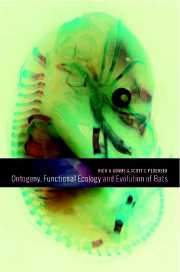Book contents
- Frontmatter
- Contents
- List of contributors
- 1 Integrating ontogeny into ecological and evolutionary investigations
- 2 Bat phylogeny: an evolutionary context for comparative studies
- 3 Early embryology, fetal membranes, and placentation
- 4 Brain ontogeny and ecomorphology in bats
- 5 Evolutionary plasticity and ontogeny of the bat cochlea
- 6 Skull growth and the acoustical axis of the head in bats
- 7 Ontogeny of the chiropteran basicranium, with reference to the Indian false vampire bat, Megaderma lyra
- 8 A theoretical consideration of dental morphology, ontogeny, and evolution in bats
- 9 Wing ontogeny, shifting niche dimensions, and adaptive landscapes
- 10 Ontogeny and evolution of the hindlimb and calcar: assessing phylogenetic trends
- 11 A comparative perspective on the ontogeny of flight muscles in bats
- 12 The ontogeny of behavior in bats: a functional perspective
- Index
3 - Early embryology, fetal membranes, and placentation
Published online by Cambridge University Press: 17 August 2009
- Frontmatter
- Contents
- List of contributors
- 1 Integrating ontogeny into ecological and evolutionary investigations
- 2 Bat phylogeny: an evolutionary context for comparative studies
- 3 Early embryology, fetal membranes, and placentation
- 4 Brain ontogeny and ecomorphology in bats
- 5 Evolutionary plasticity and ontogeny of the bat cochlea
- 6 Skull growth and the acoustical axis of the head in bats
- 7 Ontogeny of the chiropteran basicranium, with reference to the Indian false vampire bat, Megaderma lyra
- 8 A theoretical consideration of dental morphology, ontogeny, and evolution in bats
- 9 Wing ontogeny, shifting niche dimensions, and adaptive landscapes
- 10 Ontogeny and evolution of the hindlimb and calcar: assessing phylogenetic trends
- 11 A comparative perspective on the ontogeny of flight muscles in bats
- 12 The ontogeny of behavior in bats: a functional perspective
- Index
Summary
INTRODUCTION
Bats comprise a very large and diverse group of mammals, second only to rodents in numbers of species. Over 950 species of bats are so far described and often a misunderstanding is perpetrated that generalities exist within the taxonomic units, be they between suborders, families, subfamilies, or within genera. It is not uncommon to find appreciable differences relating to morphology, behavior, ecology, reproduction, and placentation among bat species. Mossman (1987) emphasized the value of using fetal membrane characters as phylogenetic indicators among the major groups of eutherian mammals, and attributed their value to conservatism as compared to the developmental and morphological characters of the individual. However, as Luckett (1980) pointed out, fetal membrane data are not clear enough in assessing chiropteran phylogeny. An attempt is made in this overview to update information and present diversities portrayed by bats with regard to preimplantation development, implantation, fetal membranes, and placentation.
OVUM MATURATION, FERTILIZATION, AND PREIMPLANTATION DEVELOPMENT
Development of the embryo
The chiropteran ovum (Fig. 3.1A, B) resembles that of other mammals (Blandau 1961). It is either round or oblong in shape, microlecithal, measures 65–75 μm in diameter (Gopalakrishna et al. 1974) with an eccentric nucleus, and is surrounded by an eosinophilic and PAS-positive zona pellucida. After ovulation the ovum shrinks. It maintains its size until hatching. Data on ovum maturation and fertilization are available for relatively few species of bats (Rasweiler 1979). The first meiotic division has been observed in mature preovulatory follicles of Carollia perspicillata and Desmodus rotundus (de Bonilla & Rasweiler 1974, Quintero & Rasweiler 1974), Noctilio albiventris (Rasweiler 1977), and few other species.
- Type
- Chapter
- Information
- Ontogeny, Functional Ecology, and Evolution of Bats , pp. 59 - 92Publisher: Cambridge University PressPrint publication year: 2000
- 2
- Cited by

